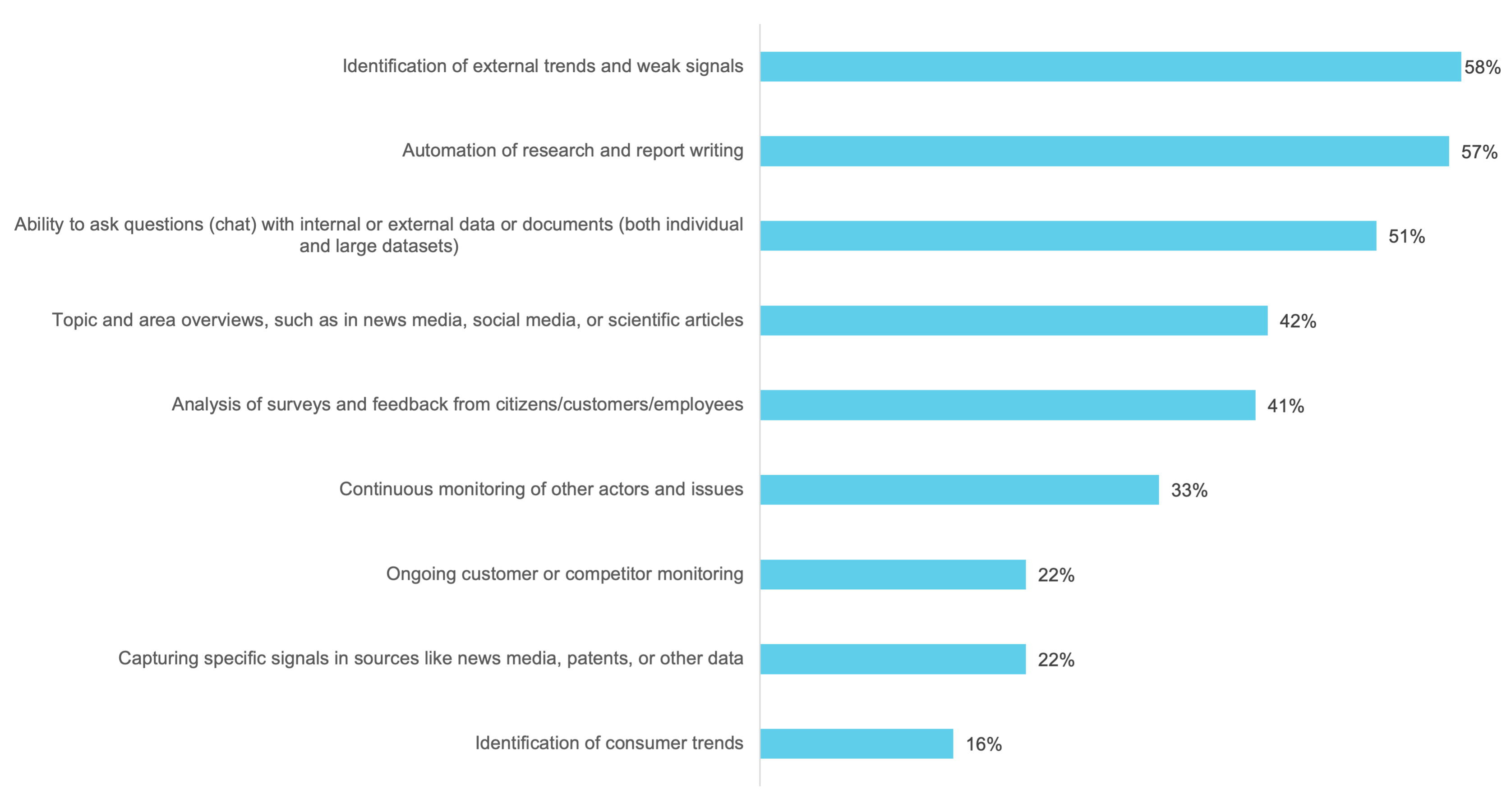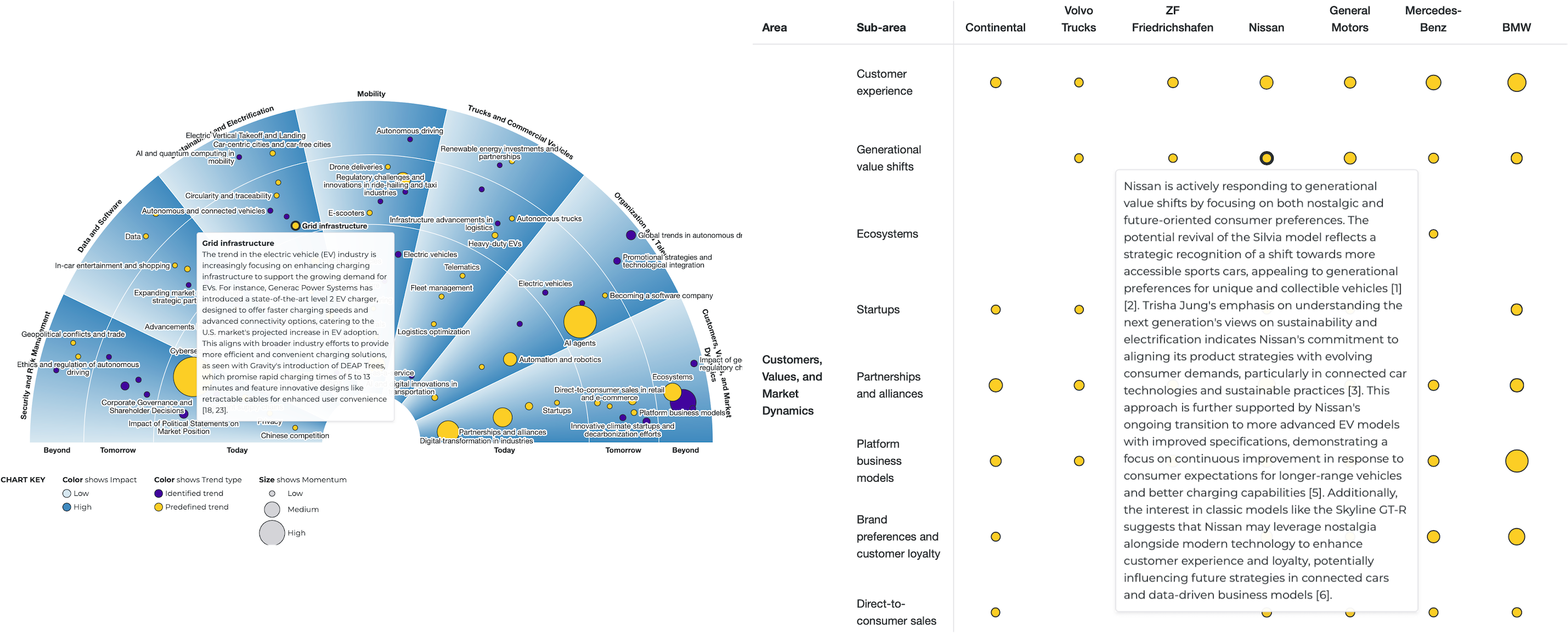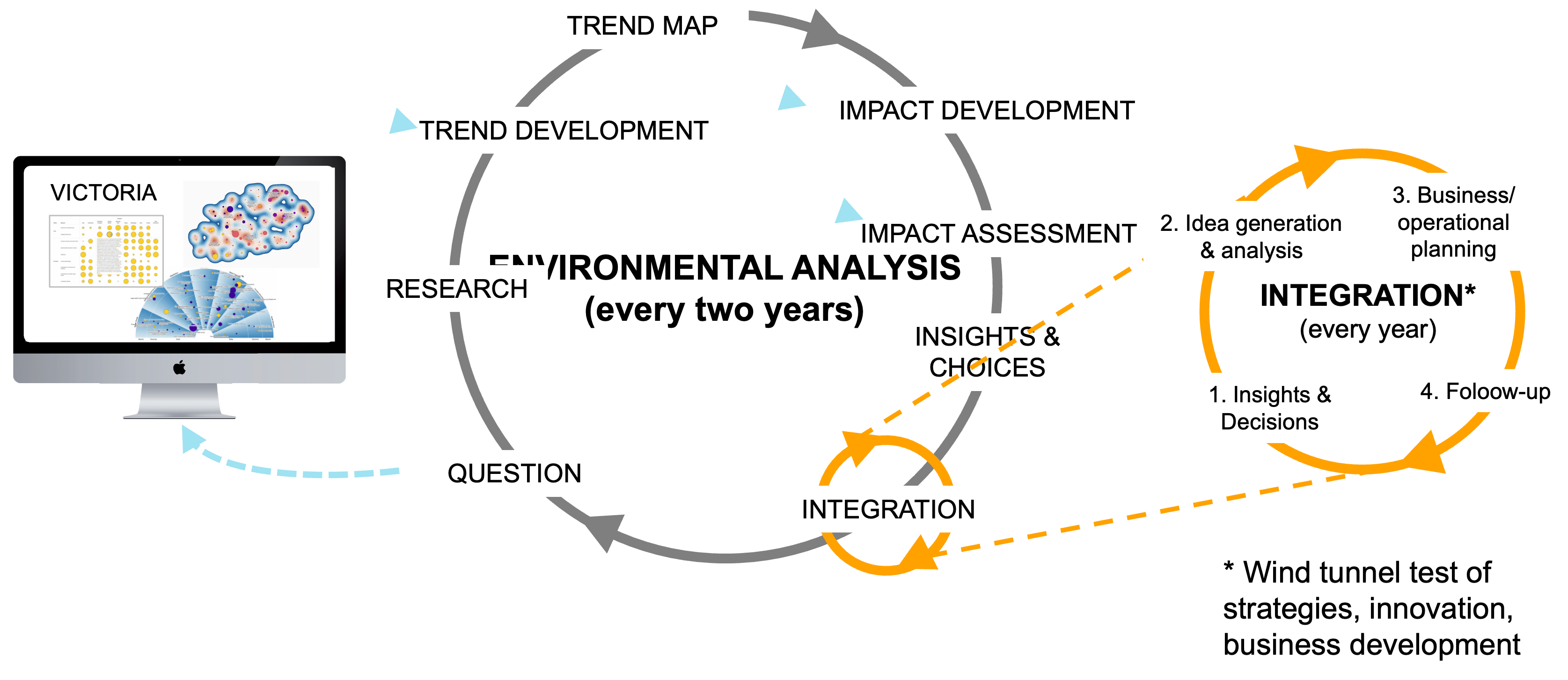Boosting Business Intelligence With AI
Imagine having an employee who gathers relevant information around the clock about what is happening in the world, what customers, competitors, and other key players are doing, thinking, and feeling – in news or social media, in reports she finds or you upload, in patents, scientific articles, or internal documents. All the things you ask it to look for that are critical to keeping track of short- and long-term risks and opportunities.
An employee who not only collects the information, but also has the ability to pick out the goodies. Someone who can summarize, sort, evaluate, and even draw conclusions about how events, decisions, and trends affect your areas of interest, the industry, and the company itself. And who can also make suggestions for decisions and actions.
Imagine, too, that this person can present his or her findings in the way that's right for you, whether it's reports or summary newsletters and alerts, whether it's visual overviews or detailed deep dives. And that they always have an answer when you have a specific question related to the areas you want them to track. In principle, this employee already exists today.
The Dream of the Perfect Assistant
That coworker seems to be what most business and operations developers, strategists and business analysts dream of. At least when they are allowed to think freely. That perfect, tireless helper who can help with almost everything, and especially with the boring parts of analysis and development work.
When we asked this question in a survey in the fall of 2023, respondents classified their dreams according to the chart below. It shows that most of all they want help identifying weak signals, getting help with research and report writing. But also to receive topic overviews, analysis of survey responses and more continuous monitoring of issues and actors.

Fig 1: 150 strategists, business developers, business planners and business analysts' categorization of their own answers to the open-ended question: “If you could make any wish, what aspect of your work related to information gathering, analysis and production of decision support would you like to automate using AI?” Kairos Future, October 2023.Click on the figure to see a larger version.
...is Almost Here
The good news is that a digital assistant is just around the corner. AI bots like ChatGPT already work well for certain tasks, such as providing a sounding board to sharpen your thinking. They can also perform basic research and summarize short reports and documents. AI-based search services like Perplexity are bringing us closer to the dream. And the agents that are starting to appear now for simpler tasks allow us to anticipate what might be coming in the reasonably near future. With agents, we are getting digital helpers that can not only perform a predetermined sequence of tasks, but can also strategize how to complete a mission and then get the job done.
However, the truly capable agents are still some way off, although there are agents today that can perform a task such as "Go through this list of organizations. Look up the information in databases or online about the organizations listed in the attached document and fill in the answers as indicated in this document. Choose the working model you prefer. The following resources are available to you...". The resources can be, for example, searching the Web, finding information on Web sites, downloading and searching PDF documents, searching databases. We have agents that we have worked with that work in this way with very good results, and it is improving rapidly.
What has enabled this explosion is, of course, the so-called large language models (LLMs) from companies like OpenAI, Anthropic, Google, and Meta, to name a few. They are improving rapidly, and there is a huge difference between GPT3 and today's GPT models, even though only a few years have passed. In many cases, the best models outperform most people in most disciplines. And the solutions built on top of them are often surprisingly good. A recent example is Google's Notebook LM solution for automatically transcribing any text into a podcast. If you haven't tried it yet, you should.
What language models themselves can't do, however, is a lot. They can't handle really large amounts of information, partly because they don't have the capacity to do so, and partly because using them to do so is incomprehensibly expensive. They are also incapable of pointing to original sources, and when they search online, they come back with limited information, in which case your own search is often more effective. The way we interact with them today, primarily through chat, is also rarely the best form of interaction.
AI that Makes a Difference is More Than a Language Model
All in all, this makes language models inadequate tools for monitoring large amounts of external information, for example. And monitoring the world properly is becoming increasingly important for more and more people. Monitoring the world only on an ad hoc basis, through major news sources or favorite channels, means that important information is often missed because many important things fly under the radar. It's like looking for information under a streetlight instead of where it is.
At the same time, it is becoming increasingly important to keep track of both the issues that are critical now and the weak signals that may be critical in the long term. In addition, there is a growing need to get comprehensive answers to questions quickly, without having to wait weeks for research.
VICTORIA – for Strategic Foresight and Decision Support
Although language models alone are not suitable for this, combining language models with other AI that compensates for the weaknesses of language models can solve the problem. Based on the results of the study, in the fall of 2023 we began development work with the AI company Dcipher Analytics to use their insight and knowledge automation platform to create a solution for AI-powered foresight, business intelligence, and strategic decision support. We call it VICTORIA because it helps companies and organizations be more successful at what they do.
VICTORIA can read huge amounts of text, hundreds or thousands of times more than ChatGPT - news media, text documents, social media, patents, etc. She can identify and summarize themes and trends in the information, but also assess how they will affect an industry or organization. You can chat with her, ask her to summarize insights into reports, and send weekly, monthly, or quarterly updates and summaries of key information.
She can do this continuously, day in and day out. But you can also use VICTORIA as a helper and support when you need to dive into a specific topic quickly, for example by scanning a section of the news media. In the near future, you will also be able to ask her to do classic desk research on her own, i.e. to search for information online and summarize it appropriately.
As you can see, VICTORIA is not a simple application built on top of ChatGPT. It is based on 15 years of experimentation at Kairos Future, where we have developed several solutions for processing large amounts of text using machine learning. At its core is a unique technology tailored for handling large amounts of text, where the language models are operations in long workflows.

Fig 2. An example of how information can be presented. On the left, a trend radar where VICTORIA automatically identifies and summarizes trends in hundreds of thousands of news articles, but also collects and summarizes information about trends we define ourselves. On the right, an example of how VICTORIA can be set up to monitor what is being written or said about different players, in this case companies in the automotive industry. Click on the figure to see a larger version.
Continuity and Integration are Key to Success
Over the years, we have regularly asked companies and organizations what benefits they derive from their external relations efforts. Time and again, the answer has been the same: it is those organizations that work continuously - not just ad hoc - and have a systematic approach. Those who not only work systematically with analysis, but also have a process for integrating the work with strategy, innovation, business development, operational and business planning. In short, those who ensure that business intelligence is not a one-off event that takes on a life of its own. And almost always it is also the case that the external work in these companies and organizations is seen as a priority by the management.
It is this systematic work that VICTORIA and other AI-powered foresight and business intelligence solutions do best. Then you can build on VICTORIA's two strengths - the ability to track and continuously update the trend map that the organization is working from to build its strategic priorities, and the ability to identify emerging issues that need to be considered and perhaps delved into to better understand where they may be going and, not least, how they may affect the organization in the long term. In all of this work, VICTORIA or similar solutions can become a real workhorse, capable of doing all the things that no human would want to do, be able to do, or be able to do, even if they had the time and resources to do it.
Fig 3. An example of a systematic foresight process conducted at appropriate intervals. The insights gained can be used for strategic development, innovation and business development. VICTORIA can speed up some of these steps through automated intelligence and analysis. In addition, identified trends can be continuously monitored for unforeseen changes in the external world. Click on the figure to see a larger version.
Do you want to learn more about Kairos Future's solutions for AI-based continuous business intelligence, foresight and decision support? Contact Mats Lindgren.

